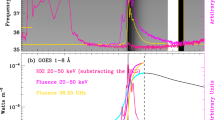Abstract
Thirty active regions were observed on the Sun during the period from October 19 to November 20, 2003. Hard X-ray and gamma-ray radiation was detected from four active regions (10484, 10486, 10488, and 10490): 14 solar flares stronger than M5.0 according to the GOES classification were recorded during this period by detectors onboard the Geostationary Operational Environmental Satellite (GOES), Ramaty High Energy Solar Spectroscopic Imager (RHESSI), and other satellites. Five of these flares (and also the M2.7 flare of October 27, 2003) were also observed by the AVS-F apparatus onboard the CORONAS-F satellite. This paper discusses the time profiles and energy spectra of the solar flares of October 26, 2003 (M7.6), and October 29, 2003 (X10), and of the initial phase of the flare of November 4, 2003 (X18), obtained by the AVS-F instrument during the passage of the satellite over the regions near the geomagnetic equator. The spectra of the M7.6 flare of October 26, 2003, and of the initial phase of the X18 flare of November 4, 2003, in the energy band from 0.1 to 17 MeV contain no lines, whereas the spectrum of the flare of October 29, 2003, exhibits nuclear lines and the 2.2-MeV line during the entire flare gamma-ray emission registration. We also report the time profiles of the flare of October 29, 2003, in the energy bands corresponding to the continuum in the energy band 0.3–0.6 MeV, the nuclear lines of 56Fe, 24Mg, 20Ne, 28Si, 12C, and 16O, and the 2.2-MeV neutron-capture line. The analysis of these temporal profile periodograms shows the presence of a thin structure with characteristic scales from 34 to 158 s at the 99% confidence level. The AVS-F apparatus analyzes temporal profiles of low-energy gamma-ray emission with a temporal resolution of 1 ms within the first 4.096 seconds of solar flares. The analysis of the data reveals no regularities in the time series on time scales ranging from 2 to 100 ms at a confidence level of 99% for these three solar flares.
Similar content being viewed by others
References
Arkhangelskaja, I.V., Arkhangelsky, A.I., and Kotov, Yu.D., Model of the Background of the AVS-F Instrument in the Low-Energy γ-Range, Sbornik nauchnykh trudov “Nauchnaya sessiya MIFI-2005” (Proc. Scientific Session of the Moscow Engineering Physics Institute-2005), Moscow: MIFI, 2005a, vol. 7, pp. 35–36.
Arkhangelskaja, I.V., Chervyakova, O.I., Arkhangelsky, A.I., et al., Investigation of Operation Stability of the Spectrometric Track of the AVS-F Apparatus in the Low-Energy γ-Range, in Sbornik nauchnykh trudov “Nauchnaya sessiya MIFI-2005” (Proc. Scientific Session of the Moscow Engineering Physics Institute-2005), Moscow: MIFI, 2005b, vol. 7, pp. 33–34.
Arkhangelsky, A.I., Glyanenko, A.S., Kotov, Yu.D., et al., AVS-F Experiment Update in the CORONAS-F Project, Sbornik nauchnykh trudov “Nauchnaya sessiya MIFI-99” (Proc. Scientific Session of the Moscow Engineering Physics Institute-99), Moscow: MIFI, 1999, vol. 4, pp. 30–31.
Glyanenko, A.S., Kovalen’, V.Yu., Kotov, Yu.D., et al., X-ray Semiconductor (CdTe) Spectrometer for Investigation of Radiation of Solar Flares and Their Precursors, Izv. Vyssh. Uchebn. Zaved., Radiofiz., 1996, vol. 34, nos. 11–12, pp. 1500–1503.
Kotov, Yu.D., Arkhangelskaja, I.V., Arkhangelsky, A.I., et al., Preliminary Results of Processing the AVS-F Data in the 0.1–11 MeV Energy Range, Izv. Akad. Nauk, Ser. Fiz., 2002, vol. 66, no. 11, pp. 1666–1668.
Kotov, Yu.D., Arkhangelskaja, I.V., Arkhangelsky, A.I., et al., Preliminary Results of Processing the AVS-F Data in the High-Energy Range, in Sbornik nauchnykh trudov “Nauchnaya sessiya MIFI-2003” (Proc. Scientific Session of the Moscow Engineering Physics Institute-2003), Moscow: MIFI, 2003, vol. 7, pp. 20–22.
Kuznetsov, S.N., Bogomolov, A.V., Gordeev, Yu.P., et al., Preliminary Results of the Experiment Performed with the SKL Equipment Set onboard the CORONAS-I Satellite, Izv. Ross. Akad. Nauk, Ser. Fiz., 1995, vol. 59, no. 4, pp. 2–6.
Ramaty, R. and Mandzhavidze, N., Gamma Rays from Solar Flares, in Highly Energetic Physical Processes and Mechanisms for Emission from Astrophysical Plasmas IAU Symp., 2000, vol. 195, no. 195, pp. 12–21.
Ramaty, R., Mandzhavidze, N., Barat, C., et al., The Giant 1991 June 1 Flare: Evidence for Gamma-Ray Production in the Corona and Accelerated Heavy Ion Abundance Enhancements from Gamma-Ray Spectroscopy, Astrophys. J., 1997, vol. 479, pp. 458–463.
Shih, A., Smith, D., Lin, R., et al., Temporal Variability of Gamma-Ray Lines from the X-class Solar Flares of October–November 2003, Proc. of the 35th COSPAR Sci. Assembly, 2005, p. 3221.
Veselovsky, I.S., Panasyuk, M.I., Avdyushin, S.I., et al., Solar and Heliospheric Phenomena in October–November 2003: Causes and Effects, Kosm. Issled., 2004, vol. 42, no. 5, p. 451 [Cosm. Res. (Engl. Transl.), vol. 42, no. 5, p. 435].
Author information
Authors and Affiliations
Additional information
Original Russian Text © I.V. Arkhangelskaja, A.I. Arkhangelsky, Yu.D. Kotov, S.N. Kuznetsov, A.S. Glyanenko, 2006, published in Astronomicheskii Vestnik, 2006, Vol. 40, No. 4, pp. 331–343.
Rights and permissions
About this article
Cite this article
Arkhangelskaja, I.V., Arkhangelsky, A.I., Kotov, Y.D. et al. Gamma-ray radiation of solar flares in October–November 2003 according to the data obtained with the AVS-F instrument onboard the CORONAS-F satellite. Sol Syst Res 40, 302–313 (2006). https://doi.org/10.1134/S003809460604006X
Received:
Issue Date:
DOI: https://doi.org/10.1134/S003809460604006X




